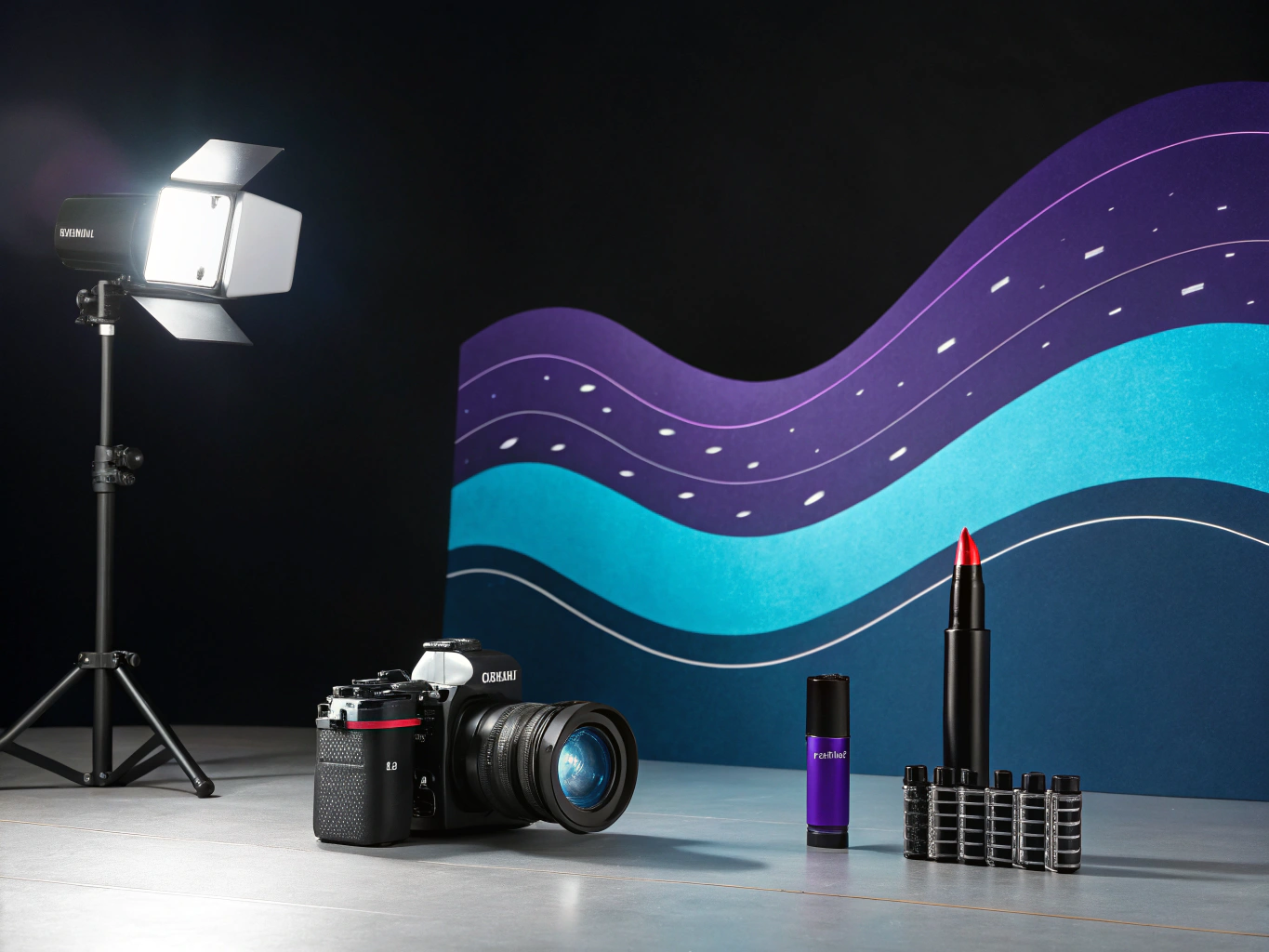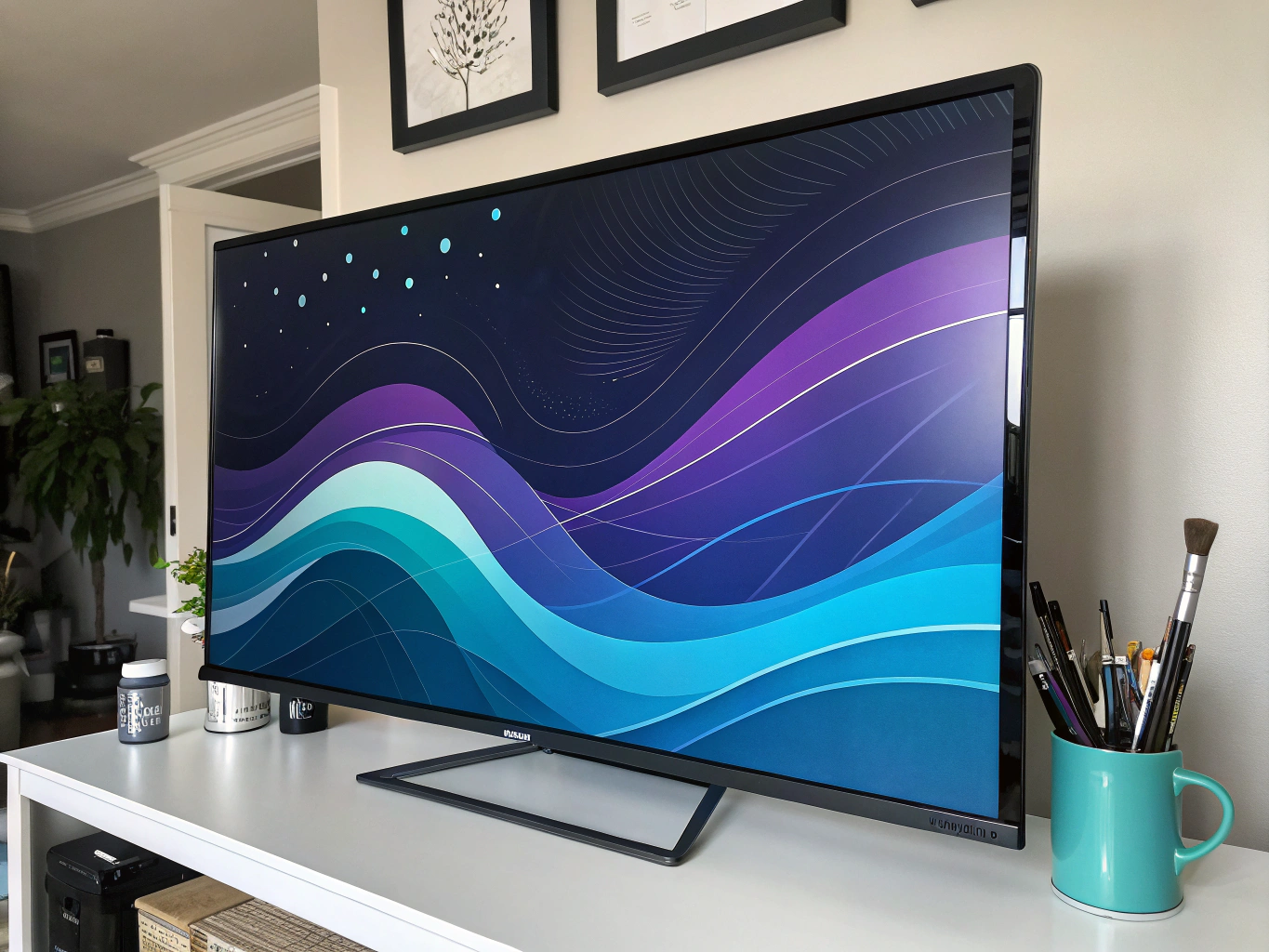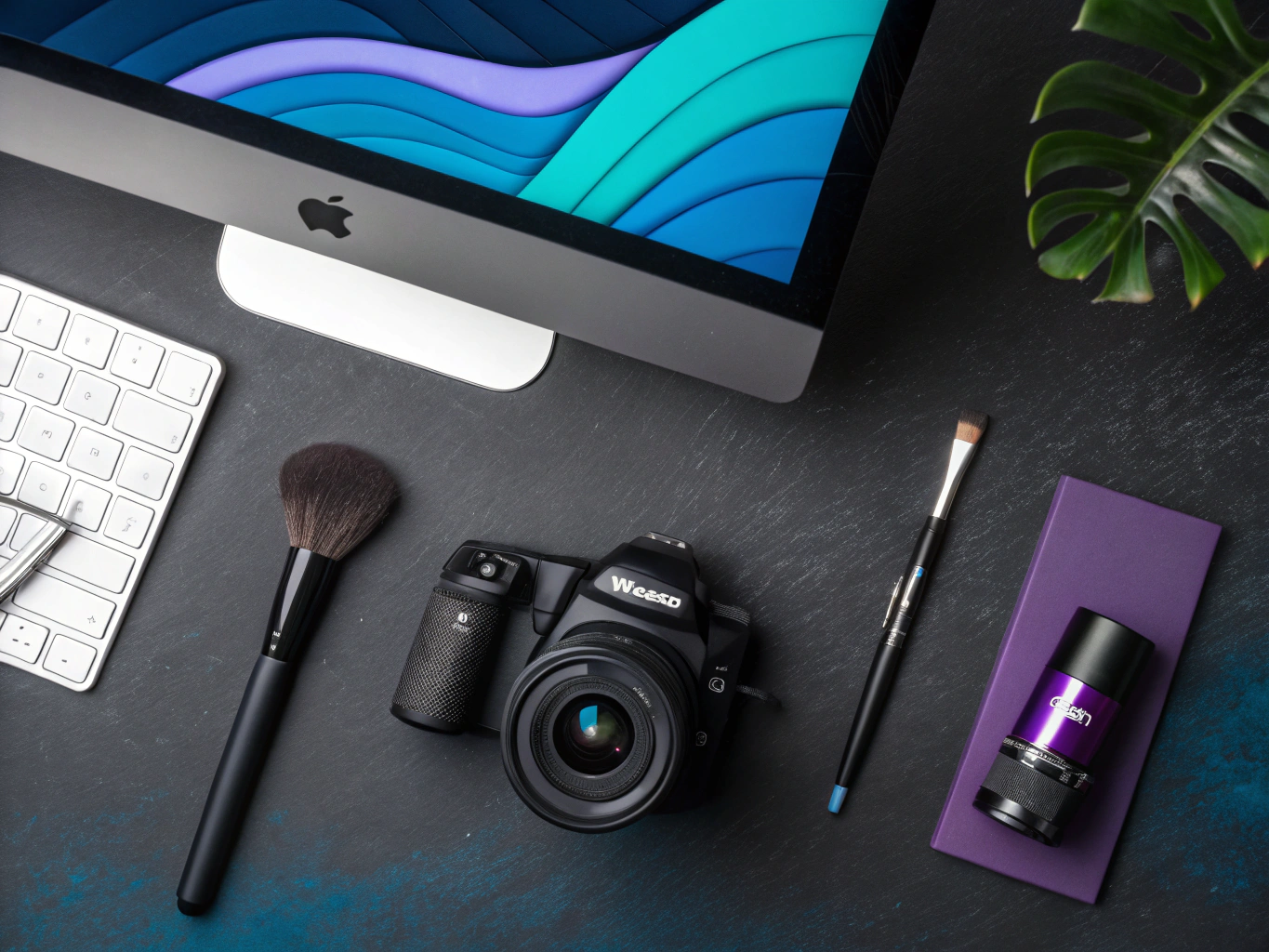The Art and Science of Cosmetic Product Photography
Let’s be honest – we’ve all been there. Scrolling through Instagram or an online store, stopping dead in our tracks at a stunning cosmetic product photo that makes us want to reach through the screen and grab that sleek foundation bottle or perfectly illuminated eyeshadow palette. But here’s the thing: those shots that seem effortless? They’re anything but. For more insights, check out our guide to beauty and wellness photography.
I’ve spent years working with brands and photographers, watching the magic (and occasional mayhem) that goes into creating those perfect product shots. And let me tell you – cosmetic product photography is like conducting a tiny orchestra where every instrument is made of glass, metal, and highly reflective surfaces trying their best to ruin your day. Discover more about this in our studio shots for AI skincare.
Why Cosmetic Product Photography Matters More Than Ever

In the age of digital-first shopping, your product photography isn’t just part of your marketing – it IS your product. Think about it: when was the last time you bought a cosmetic product online without seeing it first? That’s right, never. Your photos are the digital equivalent of that beauty counter experience, minus the overly enthusiastic sales associate spritzing you with perfume. Explore free tools for product photo backgrounds to enhance your imagery.
The Technical Dance of Light and Surface
Here’s where things get interesting (and slightly nerdy, but stay with me). Cosmetic products are basically a photographer’s nightmare wrapped in pretty packaging. You’ve got transparent bottles, metallic caps, glossy surfaces, and textures that range from powder to liquid – each demanding its own lighting technique. It’s like trying to photograph a mirror inside a glass house while maintaining perfect control over every reflection. Stay updated with photography trends that can guide you through this challenge.
Understanding different lighting techniques can make all the difference in capturing the true essence of your product, helping to manage those tricky reflections and highlight features that make your product stand out.
Essential Equipment for Professional Cosmetic Photography
Before we dive into the fancy techniques, let’s talk gear. And no, you don’t need to mortgage your house to get started. The key is understanding what each piece of equipment brings to your photographic recipe. For affordable setups, check out our Walmart beauty box for some ideas.
Camera and Lens Selection
Here’s a truth bomb: it’s not about having the most expensive camera. I’ve seen stunning cosmetic shots taken with entry-level DSLRs and mirrorless cameras. What matters more is your lens choice. A good macro lens (think 100mm) is your best friend for those ultra-close detail shots of product textures. For wider setups, a versatile 24-70mm will handle most of your needs. For inspiration, see our top product photography ideas.
Lighting: Your Make-or-Break Factor
If cameras are the heart of product photography, lighting is the soul. You’ll need at least two softboxes to start – think of them as your main light and fill light. A ring light can be handy for certain setups, but it’s not mandatory. The real game-changer? Diffusers. Lots of them. They’re like Instagram filters for real life, smoothing out those harsh reflections that make your products look like they’re in witness protection. Understand the revolutionary changes AI brings to photography.
Creating Your Studio Space

Let’s talk about turning that spare room (or corner of your living room) into a product photography studio. You don’t need a massive space – I’ve seen amazing shots come out of spaces smaller than a walk-in closet. The key is control. Control over light, control over dust (your new arch-nemesis), and control over your workflow. Learn about crafting the perfect product gallery.
The Basics of Studio Setup
Start with a solid table – stability is crucial when you’re shooting macro. Your background doesn’t need to be fancy; a sweep of seamless paper or an acrylic sheet will do wonders. The magic happens in how you control the environment around these basics. Think of your studio space as a mini ecosystem where you’re playing god with light and shadow. For more technical insights, you might find our comparison of PNG vs SVG formats useful.
Remember those early days of product photography when everyone thought a white background and direct flash would do the trick? Yeah, we’ve come a long way. Today’s cosmetic product photography is about creating mood, telling stories, and making products look so good they practically jump off the screen and into shopping carts. Understand more about return policies that might affect your photography business.
The best part? Once you understand these fundamentals, you can start breaking rules and creating your own style. Because at the end of the day, great product photography isn’t just about technical perfection – it’s about creating that emotional connection that makes someone stop scrolling and start clicking. Discover how to make money with ecommerce through your photography skills.
Essential Equipment for Professional Cosmetic Photography
Let’s talk about the elephant in the room – equipment. While I’ve seen incredible product shots taken with iPhones (seriously, some content creators are wizards), there’s a reason why professional cosmetic photography typically requires specific gear. It’s like trying to paint a masterpiece – sure, you could use crayons, but wouldn’t you rather have the right brushes? Learn how to become an Amazon reviewer to gain insights into product demands.
Camera and Lens Selection: The Foundation of Your Setup
Here’s the thing about cameras for product photography cosmetics – you don’t need the latest $5000 body. What you do need is something that gives you manual control and excellent macro capabilities. I’ve seen stunning cosmetic shots from photographers using entry-level DSLRs paired with the right lens.
Speaking of lenses – this is where you don’t want to skimp. A macro lens is your best friend for those ultra-close powder texture shots and intricate packaging details. The 100mm macro is particularly versatile for cosmetic work. For wider shots, a 24-70mm f/2.8 gives you that perfect balance of versatility and quality. You might also wonder, can you sell stuff on Amazon?
Lighting Equipment: Where the Magic Happens
Lighting is where most product photography setups either shine or fall flat (pun intended). You’ve got two main options: continuous lighting or strobes. For beginners, continuous lighting offers the advantage of “what you see is what you get.” But here’s why many product photographers near me prefer strobes: more power, faster recycling times, and better control over ambient light.
Your basic lighting kit should include:
– 2-3 lights (either continuous or strobe)
– Softboxes or diffusers
– A ring light for those perfect highlight captures
– Various reflectors and flags for controlling light spread
Support and Stability: The Unsung Heroes
Ever tried hand-holding a camera for precise product shots? Yeah, don’t. A robust tripod isn’t just nice to have – it’s essential. When you’re doing focus stacking for those ultra-sharp images that Amazon product photography guidelines demand, even the slightest camera movement can ruin your shot.
Setting Up Your Cosmetic Photography Studio

Here’s where things get interesting. You don’t need a massive studio space for product photography at home – I’ve seen incredible setups in spaces as small as a desk corner. The key is organization and control. For alternatives to common platforms, look into Alibaba alternatives for sourcing props and tools.
Creating a Controlled Environment
Light control is crucial for consistent product photography. Block out natural light (yes, all of it) and work with artificial lighting only. This gives you complete control over your exposure and color temperature. Think of it like a scientific experiment – you want to control all the variables. If privacy is a concern, learn how to turn off activity status on Instagram.
For creative product photography, consider investing in:
– A variety of backdrop materials (white seamless paper is your baseline)
– Acrylic sheets for those gorgeous reflections
– Textured surfaces for editorial-style shots
– A dust-free storage system for your props and materials
The Workflow Game: Efficiency Meets Creativity
Let’s talk workflow because this is where most photographers either thrive or dive into chaos. Set up your space so everything has its place. When you’re in the middle of a shoot and need that specific diffuser or prop, you don’t want to be digging through boxes.
Consider creating zones in your studio:
– Shooting area (primary workspace)
– Prep station (for product cleaning and styling)
– Storage (organized by category)
– Post-processing station (if space allows)
Budget-Friendly Solutions That Actually Work
Starting out? Don’t let budget constraints stop you. Some of the most impressive product shots I’ve seen came from photographers using DIY solutions. White foam board as reflectors? Brilliant. LED shop lights with diffusion material? They work surprisingly well.
The key is understanding light behavior rather than throwing money at expensive gear. You can create professional-looking images with basic equipment if you master the principles of light and composition. I’ve seen photographers near me create stunning work with minimal setups – it’s all about creativity and technical knowledge.
Mastering Lighting Techniques for Cosmetics
This is where product photography gets both technical and artistic. Understanding the four characteristics of light – quantity, quality, color temperature, and direction – is crucial for creating those scroll-stopping images that make products jump off the screen.
Think of light as your paint and your camera as your brush. Each adjustment in your lighting setup tells a different story about your product. Soft, diffused light might communicate luxury and elegance, while harder light with strong shadows could suggest power and boldness.
For more advanced tips and tricks, you might want to check out these makeup product photography tips that focus specifically on cosmetics, offering insights into capturing the best details of your products.
Remember: great product photography isn’t just about making things look pretty – it’s about creating images that sell. And in the cosmetics industry, that means capturing texture, finish, and detail in ways that make customers want to reach through their screens and touch the product.
Mastering Post-Production for Cosmetic Product Photography

Let’s be real – capturing stunning product photography for cosmetics isn’t just about fancy cameras and perfect lighting setups. The magic often happens in post-production, where even the most basic shots can be transformed into scroll-stopping content.
The Essential Post-Production Workflow
I’ve seen countless photographers get overwhelmed by post-processing, treating it like some mystical art form. But here’s the thing: it’s more like cooking with a recipe. You need the right ingredients (raw files), proper tools (editing software), and a systematic approach that doesn’t make you want to throw your computer out the window.
Color Correction: The Foundation of Cosmetic Photography
Nothing kills product photography faster than inaccurate colors. Think about it – if you’re selling a “Ruby Red” lipstick that looks more like “Burnt Orange” in photos, you’re going to have some angry customers. This is where color calibration becomes your best friend.
Start with a color checker card in your initial shots. Yes, it’s an extra step, but it’s like having a cheat code for perfect color matching. When editing, use it as your reference point to ensure your reds are actually red, your pinks are genuinely pink, and those subtle foundation shade differences are accurately represented.
Advanced Techniques for Product Photography Cosmetics
Focus stacking is your secret weapon for those ultra-sharp cosmetic shots. Think of it like HDR photography, but for focus instead of exposure. Take multiple shots at different focus points and blend them together. It’s particularly crucial for capturing every detail of that intricate perfume bottle or the texture of pressed powder.
Creative Product Photography That Converts
Here’s where we can get a bit wild with our editing. But remember – we’re not creating digital art here. The goal is to enhance reality, not replace it. Use techniques like frequency separation to perfect skin texture in swatch shots, or create compelling before-and-after demonstrations that actually look believable.
The Mobile Photography Revolution
Let’s address the elephant in the room – yes, you can take professional-looking product photos with your iPhone. The latest smartphones are basically carrying mini studios in our pockets. But here’s the catch: you need to understand the limitations and work around them.
For product photography at home, leverage natural light and invest in a few key mobile editing apps. Snapseed and Lightroom Mobile are your friends here. They’re like having a professional photo editor in your pocket, minus the hefty price tag.
Building Your Product Photography Portfolio
The best product photographers I know didn’t start with major cosmetic brands knocking on their door. They built their portfolios methodically, often starting with product photography near me searches to find local businesses needing help.
From Local to Global: Scaling Your Photography Business
Start with small brands and indie cosmetic companies. They’re often more willing to take chances on emerging photographers, and they’re perfect for building your portfolio. Plus, they typically need more creative freedom in their product shots, allowing you to experiment and develop your style.
As you grow, consider specializing in specific types of cosmetic photography. Maybe you become the go-to photographer for amazon product photography in the beauty space, or perhaps you focus on creative splash photography for skincare brands.
The Future of Product Photography
We’re seeing a fascinating shift in what clients want. The perfect, sterile product shot is giving way to more authentic, lifestyle-oriented imagery. It’s like the Instagram vs. Reality trend, but in reverse – brands want both the polished and the personal.
AI is also reshaping product photography in ways we couldn’t have imagined five years ago. Tools like ProductScope AI are transforming how brands approach product visualization, but they’re complementing, not replacing, traditional photography. Think of AI as your creative assistant, not your replacement.
Final Thoughts on Product Photography Cosmetics
Success in cosmetic product photography isn’t just about technical excellence – it’s about understanding the story each product tells. Whether you’re shooting with a professional setup or learning how to take product photos with iPhone, the principles remain the same: clarity, creativity, and commercial appeal.
Remember, every major photographer started somewhere. Maybe they googled “product photographer near me” or watched countless YouTube tutorials. The key is to start, experiment, and keep pushing your boundaries. The beauty industry isn’t just about making things look pretty – it’s about creating images that connect and convert.
And here’s my final piece of advice: don’t get too caught up in the technical perfection. Sometimes, the most successful product shots are the ones that capture the essence of the product rather than just its physical appearance. After all, we’re not just selling cosmetics – we’re selling confidence, creativity, and transformation. Learn more about cosmetic product photography to enhance your skills.
👉👉 Create Photos, Videos & Optimized Content in minutes 👈👈
Related Articles:
- A Guide to Beauty and Wellness Product Photography
- AI Studio Shots for Skincare Photography – ProductScope AI
- Top Free Tools for Editing Product Photo Backgrounds
Frequently Asked Questions
What is a product photography?
Product photography is a specialized form of commercial photography aimed at presenting products in an appealing and accurate manner to potential customers. It involves capturing images that highlight the product’s details, colors, and features, often used for advertising, online stores, and promotional materials.
What is the role of product photography?
The role of product photography is to enhance the visual appeal of a product, making it more attractive to customers and driving sales. High-quality product images can effectively communicate the value and benefits of a product, build brand credibility, and influence purchasing decisions.
What is the term for product photography?
The term for product photography is simply ‘product photography,’ but it may also be referred to as ‘commercial photography’ when used in the context of advertising and marketing. This type of photography focuses on creating compelling images that showcase products in the best possible light.
What is creative product photography?
Creative product photography involves using innovative techniques, settings, and compositions to make product images more engaging and visually striking. This approach often includes the use of unique lighting effects, backgrounds, and props to create a narrative or evoke emotions that resonate with the target audience.
What are the views of product photography?
The views of product photography typically include multiple angles and perspectives of a product to provide a comprehensive understanding of its appearance and features. Common views include the front, back, side, top, and detailed close-ups, ensuring customers can fully appreciate the product’s design and functionality.
About the Author
Vijay Jacob is the founder and chief contributing writer for ProductScope AI focused on storytelling in AI and tech. You can follow him on X and LinkedIn, and ProductScope AI on X and on LinkedIn.
We’re also building a powerful AI Studio for Brands & Creators to sell smarter and faster with AI. With PS Studio you can generate AI Images, AI Videos, Blog Post Generator and Automate repeat writing with AI Agents that can produce content in your voice and tone all in one place. If you sell on Amazon you can even optimize your Amazon Product Listings or get unique customer insights with PS Optimize.
🎁 Limited time Bonus: I put together an exclusive welcome gift called the “Formula,” which includes all of my free checklists (from SEO to Image Design to content creation at scale), including the top AI agents, and ways to scale your brand & content strategy today. Sign up free to get 200 PS Studio credits on us, and as a bonus, you will receive the “formula” via email as a thank you for your time.

